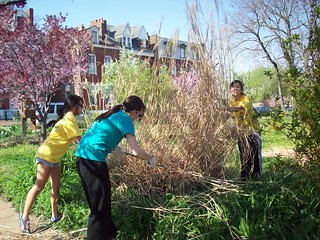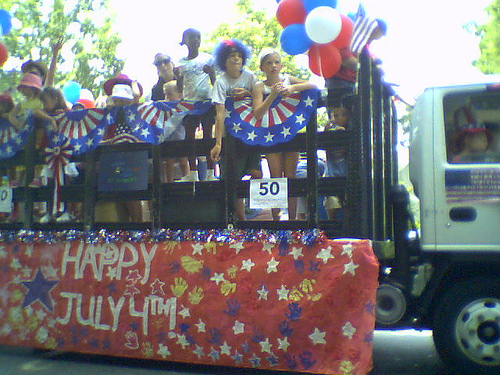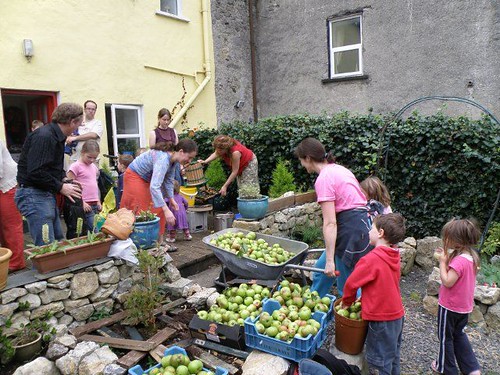A look at "seven keys to stronger community"

Posted October 22, 2012 at 1:28PM
I am fortunate to have befriended, one way or another, some people who are very good at the business of thinking about, designing, and building good communities. While many of them are architects and planners, primarily concerned with physical space, community-building is an art with elusive goals, as Eric Jacobsen’s book (reviewed here last week) argues: even if you get the physical elements right, there’s no guarantee that a place will function as a true community, as more than just a place.
That said, it really helps to have a good place in which to anchor true community. One of my community-building friends is Scott Doyon, a partner in a planning firm that signals its interest in place loud and clear: it’s called PlaceMakers. They do fantastic work, and every one of the firm’s principals that I have met is thoughtful about it. (That’s not to say that I am thrilled with everything their clients do, of course.) I’m impressed with much of their work, such as their planning assistance to Ranson, West Virginia that I profiled here last year.
Scott is a good and creative writer, and earlier this month he posted on the firm’s blog a provocative article called “Seven Keys to Stronger Community.” This follows a great tradition in nonfiction writing of numbering things: In the last five years, I’ve written articles myself about eight components of a healing city, eight pillars of a sustainable community, the ten worst things about sprawl, nine low-tech steps for resilience in a warming climate, seven rules for sustainable communities, five videos that could change the way you see cities, five graphs and four photos on obesity and walking, five provocative ways to think about cities, and five ways to use LEED-ND. It’s embarrassing to see when I line them up like that, but some of us, definitely including myself and perhaps including Scott, just seem to be compulsive about trying to organize our thoughts.
So was the Old Testament, it would seem, since Moses is said to have found the Commandments chiseled into a format of ten on  Mount Sinai long before David Letterman ever composed a Top 10 list of his own (which hasn’t been funny in at least ten years, but I digress).
Mount Sinai long before David Letterman ever composed a Top 10 list of his own (which hasn’t been funny in at least ten years, but I digress).
Here are Scott’s seven keys to stronger community:
- Good governance
- Walkable, connected, mixed-use character
- Parks and gardens
- Partnerships
- Programming
- Neighborhood-responsive schools
- Tree culture
I like it that at least three on the list have only an indirect connection to physical space. Given that Scott’s firm is all about planning and design, the easy way to write the article (and one most consistent with marketing the firm’s work) would have been to emphasize land use, the subject they know best. Scott does make a plug for form-based codes in item number two but, really, all of the others are about more than land use, to at least some degree.
I was pleased to see parks and gardens on the list. A while back I made a similar point about the usefulness of parks and greenery to Walk Appeal, the concept recognizing that some places entice longer walks than others. I was challenged on that point in a Facebook debate, by someone who felt parks were overrated, and that “good urbanism” was better. I disagree – in fact, I said then and say again now that good parks and the integration of nature and gardens into our city environment is good urbanism. That’s not to say that there aren’t plenty of parks that don’t integrate well enough; there can be inferior green spaces (note my misgivings about the National Mall in DC) just as there are inferior buildings and streets. That doesn’t mean we don’t benefit considerably from good ones, as the research confirms.
With regard to tree culture, Scott would like to see the emphasis shift from saving trees to planting them. Fighting to save trees, he contends, is divisive; planting them is unifying, and thus more conducive to building community. I think we should do both, saving the ones that are special, and planting new ones for future generations to treasure and want to save.  I’m not saying that every tree should be saved, just as I don’t think Scott is saying that none of them should be. But let’s not choose between the two approaches to an important community asset.
I’m not saying that every tree should be saved, just as I don’t think Scott is saying that none of them should be. But let’s not choose between the two approaches to an important community asset.
For my feelings about the power of partnerships, just read my post from last week about Codman Square in Boston. The point about programming is a good one, too, and often overlooked: animate your community with special events and things to enjoy. And I agree strongly with Scott’s emphasis on neighborhood-based schools.
So I’m basically saying this is a very good list. How would I change it? I might combine parks and gardens with trees and add a point about controlling sprawl. Few things have hurt true community in the US more than the flight of people, jobs, investment and activity from our traditional towns and urban neighborhoods out into the countryside, and one way to help keep communities strong and well-bonded is to keep them, and their cities, robust and intact. Much as we would like to be able to do that by devoting ourselves only to strengthening the insides of communities, it won’t be enough unless we also pay attention to what’s going on outside them.
Stopping sprawl isn’t a feel-good activity like planting trees, unfortunately; it involves sticking your neck out for what you believe. But it matters. When we're in the business of building and strengthening community, we can't just let that part of it be someone else's problem.
But I won’t belabor that point in this post. With or without my addition, Scott has given us a good list. Mark Holland’s “eight pillars of a sustainable community” would add a healthy food system and economic development to the list  (along with good environmental management systems, but I think that ventures a bit from “community” as Scott was using the word). The Knight Foundation’s research would add “openness.” (Knight’s interim findings said: “To get at this trait, researchers asked whether the community was a ‘good place for’ different groups of people - senior citizens, racial and ethnic minorities, families with kids, gays and lesbians, college graduates, and immigrants from other countries.”)
(along with good environmental management systems, but I think that ventures a bit from “community” as Scott was using the word). The Knight Foundation’s research would add “openness.” (Knight’s interim findings said: “To get at this trait, researchers asked whether the community was a ‘good place for’ different groups of people - senior citizens, racial and ethnic minorities, families with kids, gays and lesbians, college graduates, and immigrants from other countries.”)
Read Scott’s very good article here. What would you add?
Related posts:
- Looking for a model of a walkable, green, community-serving school? Start here. (July 20, 2012)
- Does a sustainable community need a good drinking establishment? (May 31, 2012)
- What does community mean to you? (June 7, 2011)
- Libraries as green community and neighborhood anchors (January 31, 2011)
- Walkable neighborhoods have higher levels of trust, community participation (December 15, 2010)
- Zoning reform, libertarianism, and the nature of community (February 26, 2010)
- Block parties - mini-festivals of community (September 8, 2009)
- Starksboro builds community and its future upon residents' stories (December 26, 2008)
Move your cursor over the images for credit information.
